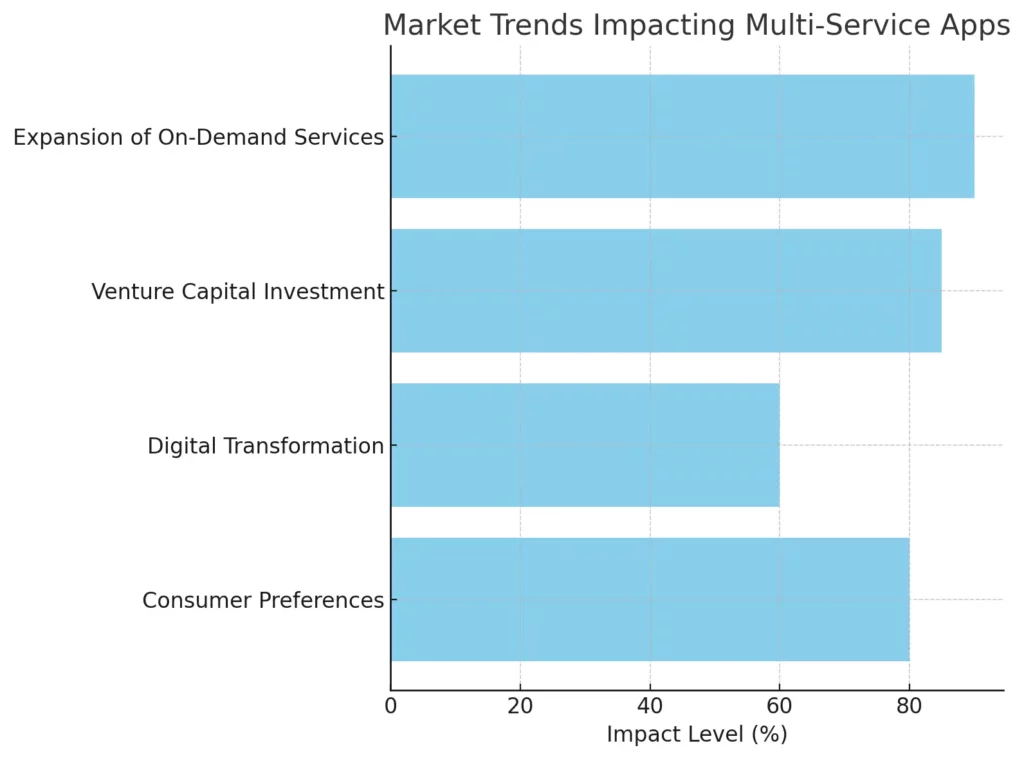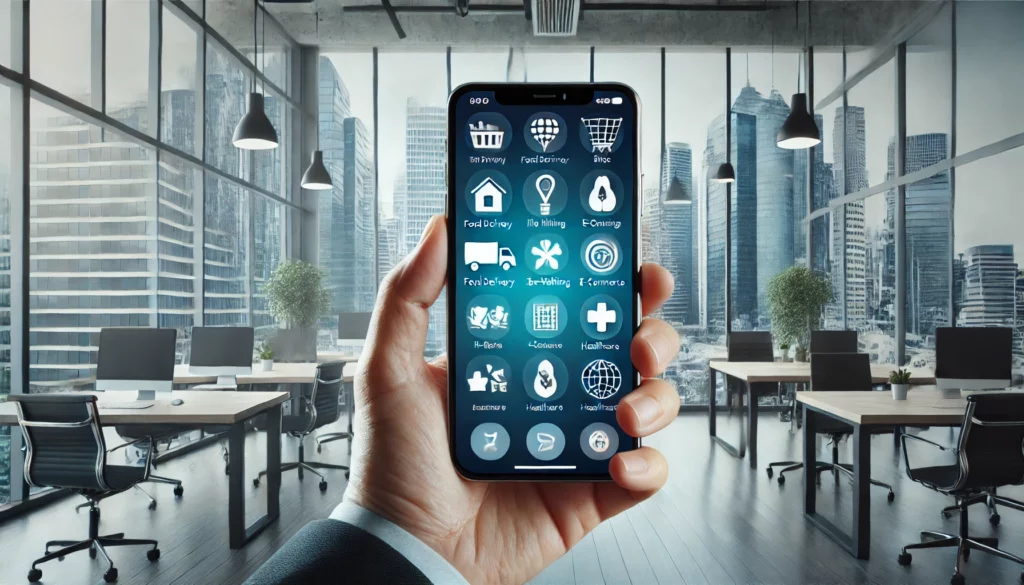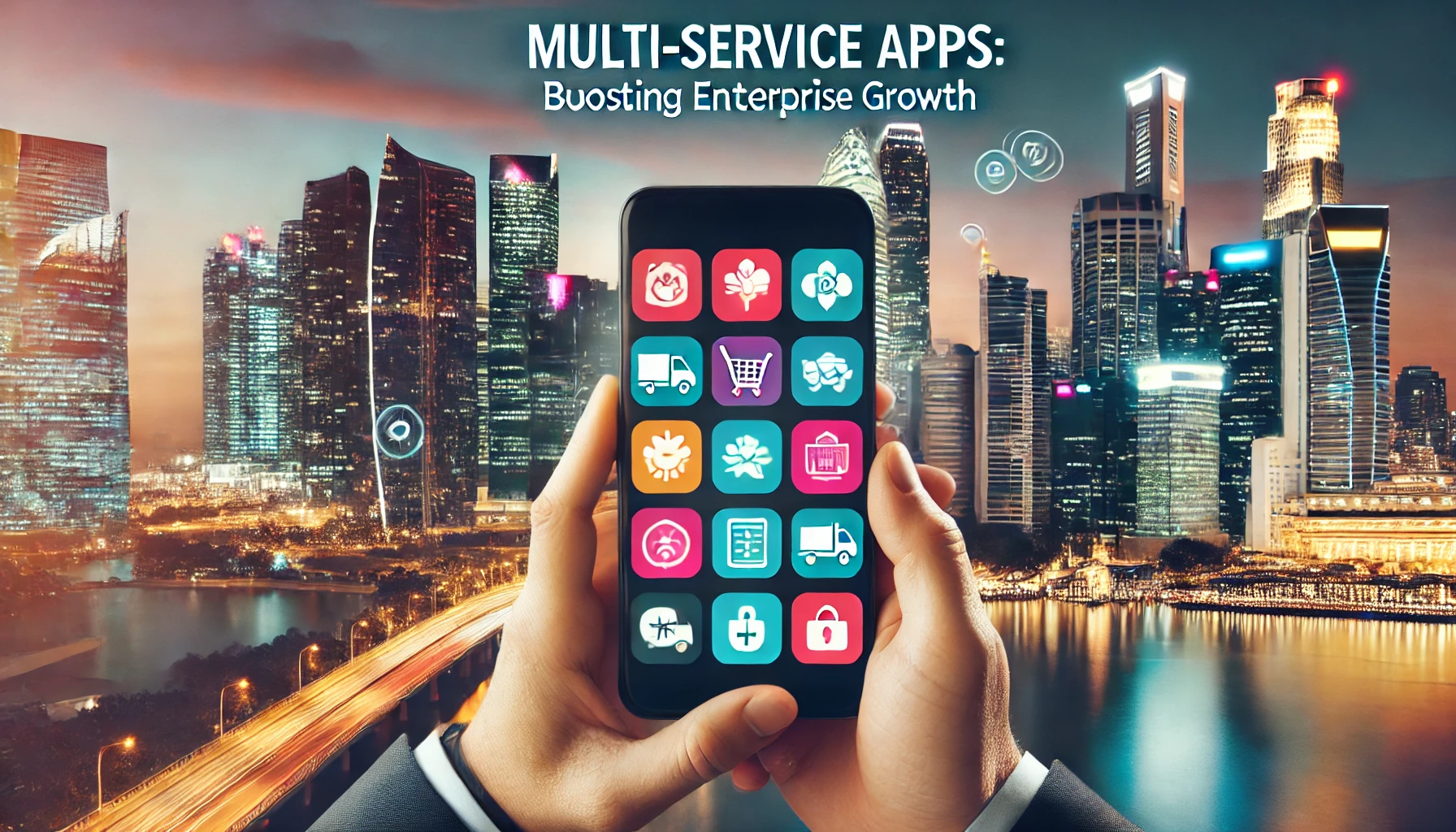In today’s fast-paced digital economy, enterprises are constantly seeking ways to streamline operations, enhance customer engagement, and diversify their services. One trend that has taken off, especially in the on-demand economy, is the rise of multi-service apps. These platforms, sometimes called super apps, offer multiple services under a single umbrella, allowing users to access a variety of services from one app.
But are multi-service apps the best solution for every enterprise? In this guide, we will explore the pros and cons of adopting a multi-service app for boosting enterprise growth, so you can decide if it aligns with your business model.
What is a Multi-Service App?
A multi-service app o super app combines several services into one platform. For instance, apps like Gojek or WeChat offer everything from ride-hailing and food delivery to mobile payments and shopping, all from a single interface. These apps are highly popular in regions like Southeast Asia, where consumers prefer a one-stop solution for their daily needs.
Different Types of Multi-Service Apps
Multi-service apps come in different forms, catering to various user needs and industries. Here are some common types:
- Aplicaciones de servicio bajo demanda
These apps provide users with multiple on-demand services such as ride-hailing, food delivery, and home services. Examples include Gojek y Grab. These apps are widely used in metropolitan areas where convenience and quick access to services are prioritized. - E-commerce-Based Multi-Service Apps
These apps offer a wide range of shopping options, combining retail, grocery delivery, and financial services. Apps like WeChat y Paytm fall into this category, providing both shopping and financial transaction capabilities. - Financial Super Apps
Super apps that focus on financial services such as banking, mobile payments, investment, and insurance. Examples include Alipay y Paypal, where users can manage all their financial needs from a single platform. - Lifestyle & Entertainment Multi-Service Apps
These apps offer services like event booking, movie tickets, digital content streaming, and social interaction, all in one platform. WeChat is a great example, offering a mix of messaging, social media, and entertainment options alongside payments and bookings.
Market Trends for Multi-Service Apps
El ascenso de multi-service apps o super apps has been a defining trend in the tech world, particularly in regions like Southeast Asia, India, and China. These apps, which offer multiple services from a single platform, have seen an increasing adoption rate, fueled by the demand for convenience and seamless digital experiences. Some key trends driving the growth of multi-service apps include:
- Consumer Preferences: Modern consumers are leaning towards apps that provide all-in-one solutions, minimizing the need to download multiple apps.
- Transformación digital: Enterprises are digitizing services, making it easier to integrate multiple functions into a single app.
- Venture Capital Investment: The success of super apps like Gojek, Grab, and WeChat has attracted significant venture capital interest, leading to new super apps emerging in different regions.
- Expansion of On-Demand Services: The pandemic accelerated the demand for on-demand services such as food delivery, ride-hailing, and e-commerce, creating opportunities for multi-service platforms.
Market Trends for Multi-Service Apps
| Industria | Common Multi-Service Features | Growth Potential | Desafíos |
|---|---|---|---|
| Servicios a pedido | Ride-hailing, food delivery, courier services | Alto | High competition, operational scaling |
| Cuidado de la salud | Telemedicine, appointment scheduling, pharmacy delivery | Muy alto | Regulatory compliance, data security |
| Minorista | E-commerce, payments, loyalty programs, customer support | Alto | UX complexity, logistics management |
| Financial Services | Mobile payments, loans, investments, insurance | Alto | Financial regulations, fraud prevention |
| Logística | Fleet management, real-time tracking, invoicing, shipment scheduling | Alto | Real-time tracking, operational costs |
Now, here’s a visual chart that reflects these trends:

The Pros of Multi-Service Apps for Enterprises
1. Increased User Retention and Engagement
One of the biggest advantages of multi-service apps is their ability to increase user retention. When users can access multiple services like ride-hailing, grocery shopping, or even booking healthcare appointments all in one app, they are more likely to stay engaged.
By providing a broader scope of services, enterprises can ensure that users keep returning to the platform for different needs, which translates to increased customer loyalty y higher retention rates.
2. Revenue Diversification
For enterprises, relying on a single service offering can be risky. A multi-service app enables businesses to diversify their revenue streams. By offering additional services—such as on-demand deliveries, financial services, or even e-commerce—enterprises can generate income from different verticals, reducing dependency on one revenue stream.
This diversified business model ensures that the company can weather market fluctuations better and stay competitive in dynamic industries.
3. Economies of Scale
With a multi-service app, enterprises can leverage existing infrastructure to support a variety of services. For example, an on-demand service app that offers ride-hailing can expand into food delivery using the same pool of drivers, reducing operational costs while offering more services.
The ability to scale services within a unified infrastructure can lead to significant savings, which is especially important for startups or enterprise app development projects looking for cost-effective growth strategies.
4. Enhanced Data Analytics and Personalization
The more services a user engages with, the more data the enterprise can collect about their preferences, habits, and behaviors. This data can be analyzed to provide personalized recommendations, targeted marketing, and customer-centric improvements.
By using Perspectivas basadas en datos, enterprises can enhance user experiences, tailor services to individual needs, and ultimately boost conversion rates.
The Cons of Multi-Service Apps for Enterprises
1. Complex Development and Maintenance
While the idea of a multi-service app may seem attractive, developing one comes with inherent complexity. Each service requires its own features, user interface, and backend integrations, making the development process significantly longer and more costly.
Additionally, ongoing maintenance can become a burden as each service will require updates, bug fixes, and feature enhancements. If not managed carefully, this can lead to inefficiencies and reduced app performance, which can harm the user experience.
2. High Initial Investment
Building a multi-service app requires significant investment upfront, not only in terms of development but also in marketing, user acquisition, y infrastructure setup. For smaller enterprises or startups, this could pose a challenge, as the app may take longer to break even or turn a profit.
To compete with well-established super apps, new entrants would need to invest heavily in branding, customer acquisition strategies, and service integration, which could stretch budgets thin.
3. Market Saturation
In regions where super apps dominate, such as Asia, launching a new multi-service app can be difficult. Competing with established giants like Gojek, Grab, or WeChat might lead to market saturation, where newer entrants struggle to differentiate their offering.
Additionally, as these large players expand their service portfolios, they have the resources to outspend and out-innovate smaller competitors, making it harder for enterprises to achieve significant growth in the short term.
4. Operational Complexity
Running multiple services simultaneously can be operationally complex, requiring skilled management and cross-functional teams. This complexity increases the chances of operational bottlenecks, poor service quality, and ultimately user dissatisfaction.
Enterprises venturing into the multi-service business model must ensure they have the necessary infrastructure, technology, and workforce to support these operations. Otherwise, they risk alienating their users due to service delays or performance issues.
Steps to Develop a Multi-Service App
Developing a multi-service app requires careful planning, technical expertise, and robust infrastructure. Below are the critical steps involved in building a successful multi-service app:
- Market Research & Validation
Conduct thorough market research to identify the services your app will offer, analyze competitors, and validate the demand for these services. - Select the Core Features
Decide on the primary services your app will offer, such as ride-hailing, food delivery, or mobile payments. Each service should be supported by its dedicated feature set. - Diseño UI/UX
A seamless and intuitive user interface (UI) is crucial for a multi-service app. Design wireframes and prototypes to ensure a smooth user experience (UX). - Desarrollo backend
Develop a scalable backend infrastructure that can support multiple services. This step involves API integration, database management, and cloud server setup. - Service Integration
Integrate third-party services (e.g., payment gateways, mapping services) that will enhance the functionalities of your app. - Pruebas y control de calidad
Test each service within the app to ensure seamless operation. Conduct performance testing, bug fixes, and usability assessments. - Launch & Marketing
Once development is complete, launch the app in the market, supported by a comprehensive marketing campaign to attract users.
Cost of Developing a Multi-Service App
The cost of developing a multi-service app depends on factors such as the number of services, the complexity of features, and geographic location of the development team. Below is a table outlining the typical cost breakdown:
| Etapa de desarrollo | Costo estimado (USD) |
|---|---|
| Investigación y planificación de mercados | $5,000 – $10,000 |
| Diseño UI/UX | $8,000 – $15,000 |
| Backend & API Development | $25,000 – $50,000 |
| Service Integration | $10,000 – $20,000 |
| Pruebas y control de calidad | $7,000 – $15,000 |
| Launch & Marketing | $5,000 – $10,000 |
| Costo total estimado | $60,000 – $120,000 |
Multi-Service App Cost Calculator
Multi-Service App Cost Calculator
Total Estimated Cost: $0
Miracuves’ Multi-Service App Solution for $3,999 Only!
Miracuves is offering an incredible, affordable solution for businesses looking to develop a multi-service app at just $3,999. This package includes everything you need to get started with a full-featured multi-service app, including core service functionalities, integrations, and a user-friendly interface.
| Service/Feature | Included in $3,999 Package |
|---|---|
| Core Multi-Service Features | Included |
| UI/UX Design & Customization | Included |
| API & Third-Party Integrations | Included |
| Pruebas y control de calidad | Included |
| Launch Assistance | Included |
| Customer Support & Maintenance | Optional (Extra Cost) |
| Total | $3,999 |
Casos de éxito
| Aplicación | Región | Core Services | Challenges Faced | Conclusión clave |
|---|---|---|---|---|
| Gojek | Southeast Asia | Ride-hailing, food delivery, payments | Scaling services, competition | Leveraging existing infrastructure to expand into multiple services. |
| China | Messaging, payments, e-commerce | Data security, managing UX for multiple services | Seamless integration of various services, creating a lifestyle platform. | |
| Grab | Southeast Asia | Ride-hailing, food delivery, finance | Regional regulations, operational complexity | Localization and strategic partnerships enabled scalable growth. |
Including real-world success stories demonstrates the potential of multi-service apps and provides tangible evidence of how these platforms can revolutionize industries. Here are a few notable case studies that highlight the advantages and challenges of multi-service apps:
How Gojek Scaled Its Super App Model to Dominate Southeast Asia
Gojek started as a simple ride-hailing service in Indonesia, but it quickly expanded into a full-fledged super app offering over 20 services, including food delivery, digital payments, and logistics. One of Gojek’s biggest strengths was its ability to leverage its existing user base and infrastructure to scale these services seamlessly.
Desafíos:
- Gojek faced tough competition from Grab and other local startups, but it differentiated itself through its multi-service model, which provided users a comprehensive ecosystem of services.
- Building the backend infrastructure to support various services and handling logistics at such a large scale were significant hurdles.
Conclusión clave:
Gojek’s success lies in its ability to create an interconnected ecosystem, driving user retention by offering multiple services on one platform. It illustrates how multi-service apps can grow rapidly in regions where users prefer a one-stop-shop experience. Gojek’s Super App success story.
WeChat: From Messaging App to Lifestyle Platform
WeChat began as a simple messaging app but evolved into China’s leading super app, incorporating features like mobile payments (WeChat Pay), e-commerce, gaming, and ride-hailing services. With over 1 billion monthly active users, WeChat became indispensable in China’s everyday life.
Desafíos:
- The shift from being a social app to an all-encompassing platform required WeChat to invest heavily in data security and user privacy.
- Managing different services within a single app interface while maintaining user-friendliness posed a UX challenge.
Conclusión clave:
WeChat shows how super apps can thrive in environments where consumers prefer convenience and all-in-one solutions. Its success is built on seamless integration of services across diverse sectors, from entertainment to finance.
Grab: From Ride-Hailing to Southeast Asia’s Super App
Initially a ride-hailing service, Grab expanded into various verticals like food delivery, financial services (GrabPay), and e-commerce. Operating in multiple countries across Southeast Asia, Grab effectively localized its offerings to cater to regional preferences.
Desafíos:
- Grab faced the challenge of scaling its services while adhering to the varying regulatory landscapes across different countries.
- Another hurdle was maintaining operational efficiency while managing multiple services.
Conclusión clave:
Grab’s ability to localize its services and partner with regional players (e.g., local restaurants, banks) helped it capture a diverse user base. The multi-service model allows Grab to continuously expand its reach and offer more value to its users.
Industry-Specific Use Cases
| Industria | Potential Services | Beneficios clave |
|---|---|---|
| Minorista | Shopping, payments, loyalty programs, delivery | Increased customer retention and engagement |
| Cuidado de la salud | Appointment booking, virtual consultations, pharmacy delivery | Improved patient satisfaction and care |
| Logística | Shipment tracking, fleet management, invoicing | Enhanced transparency and operational efficiency |
| Financial Services | Payments, loans, insurance, investments | Greater financial inclusion, diversified revenue |
| Transportation | Ride-hailing, ticket booking, parking management | Streamlined public and private mobility |
Multi-service apps are not just confined to sectors like ride-hailing or food delivery. Numerous industries can benefit from integrating various services into one platform, enabling them to scale operations and offer more value to customers. Here are some industry-specific use cases:
Retail: Enhancing Customer Experience
Retail businesses can leverage multi-service apps to combine shopping, payments, delivery, and loyalty programs into one seamless platform. Imagine an app where users can browse products, pay using integrated wallets, and get same-day delivery—all within a single interface.
Ejemplo:
A retail chain could introduce a multi-service app where users can:
- Order groceries or fashion items.
- Access an integrated rewards program.
- Book home services like appliance repair.
Key Benefit:
By offering multiple services under one app, retail businesses can increase customer retention and build loyalty through seamless experiences.
Healthcare: Revolutionizing Patient Care
In the healthcare industry, multi-service apps can unify appointment booking, telemedicine, online prescriptions, and health monitoring. This would allow patients to manage their healthcare needs efficiently, reducing the time spent navigating between different apps or services.
Ejemplo:
A healthcare provider could offer an app where users can:
- Book doctor appointments.
- Access virtual consultations.
- Track health metrics through integrated wearable devices.
Key Benefit:
By consolidating healthcare services in one app, healthcare providers can improve patient satisfaction and streamline care delivery, offering both in-person and remote health management options.
Logistics: Optimizing Supply Chains
Logistics companies can use multi-service apps to manage various aspects of the supply chain, including tracking, shipping, and fleet management. With a single app, businesses can monitor inventory, schedule shipments, and even handle payments, all in real-time.
Ejemplo:
A logistics company could offer:
- Real-time shipment tracking for clients.
- Integrated payment and invoicing services for suppliers.
- Fleet management tools for drivers and dispatchers.
Key Benefit:
Multi-service apps in logistics enable faster decision-making, improved tracking, and greater transparency across the supply chain, helping businesses optimize operations and reduce costs.
Transportation: Streamlining Public and Private Mobility
Transportation businesses, whether public transit systems or private taxi services, can benefit from multi-service platforms that combine ticket booking, ride-hailing, and even parking services. By integrating multiple transportation services into a single app, businesses can offer users a more convenient way to navigate their cities.
Ejemplo:
A transportation company could provide:
- Public transit schedules and ride-hailing services in one app.
- Parking availability and real-time traffic data.
Key Benefit:
Multi-service apps streamline the transportation experience by offering real-time information and convenient service options, improving customer satisfaction and boosting operational efficiency.

Challenges in Developing and Scaling Multi-Service Apps
While multi-service apps offer numerous benefits, they also come with their own set of challenges:
- Development Complexity
Building a multi-service app requires integrating several functionalities (e.g., payments, delivery, ride-hailing) within a single platform. This increases the technical complexity and demands sophisticated backend infrastructure to manage multiple services without compromising performance. - High Maintenance Costs
As the app grows, maintaining multiple services within one platform becomes resource-intensive. Regular updates, feature additions, bug fixes, and security patches are required for each service, leading to higher operational and maintenance costs. - Data Security and Privacy
With multiple services comes an influx of data, and ensuring its security is a major challenge. Implementing advanced encryption, fraud detection, and compliance with data protection regulations (such as GDPR) can be difficult. Best practices for app data security. - User Experience (UX) Management
Providing a smooth user experience across multiple services is tough. Users expect seamless navigation, and managing the interface for several distinct services without cluttering the app is a constant design challenge. - Competition from Existing Players
Markets with established super apps like Gojek, WeChat, y Grab can be difficult to penetrate. Competing with these giants requires a unique value proposition or targeting an underserved market segment.
Possible Market Penetration Strategies for Multi-Service Apps
To succeed in a competitive market, businesses need to craft a robust market penetration strategy. Here are a few possible approaches:
- Centrarse en nichos de mercado
Rather than launching a multi-service app targeting broad markets, focus on underserved niches. For example, create a multi-service app specifically for rural areas or smaller towns where existing super apps have limited presence. This can build a loyal user base without directly competing with industry giants. - Localized Services
Localizing services based on the specific needs of the market can set you apart. For instance, focusing on regional language support, providing hyper-local services (e.g., local delivery), or offering region-specific payment gateways can help penetrate markets with strong cultural or logistical differences. - Partnerships and Collaborations
Partner with other businesses to integrate their services into your app. Collaborations with local restaurants, logistics companies, or financial institutions can help provide a comprehensive suite of services and grow your user base. Strategic partnerships allow you to expand your service offerings without building everything in-house. - Freemium and Loyalty Programs
Ofreciendo una freemium model where users can access core services for free while unlocking premium features through subscriptions is an effective strategy to attract a wider audience. Additionally, loyalty programs, referral bonuses, and in-app rewards can help boost user retention and engagement. - Aggressive Marketing and User Acquisition Campaigns
Invest in marketing campaigns that promote your app’s unique value propositions. This can include digital marketing strategies such as social media ads, influencer collaborations, and targeted email campaigns, alongside traditional marketing efforts like billboards and radio ads. Offering launch discounts or exclusive promotions can also drive initial downloads and adoption. - Leverage Data to Improve Services
Use the data generated by your app to continuously improve user experiences and offer personalized services. By optimizing your services to meet customer expectations, you can build a loyal base that prefers your app over competitors.

Revenue Model for Multi-Service Apps
Multi-service apps offer multiple streams of revenue, making them highly profitable for enterprises. Here are some common revenue models:
- Modelo basado en comisiones
Charge a commission on each transaction processed through the app, such as ride fares, food deliveries, or e-commerce orders. - Tarifas de suscripción
Offer premium services for a subscription fee, providing users access to exclusive features like faster deliveries, discounts, or loyalty points. - Publicidad
Run in-app advertisements, either via third-party ad networks or through direct partnerships with businesses, generating additional revenue. - Tarifas de servicio
Apply service fees for specific actions such as booking a service, late cancellations, or premium support, offering another stream of revenue.
By leveraging these revenue models, multi-service apps can generate continuous income across various verticals, ensuring long-term profitability for enterprises.
| Modelo de ingresos | Descripción | Ventajas |
|---|---|---|
| Basado en comisiones | Charge a commission on each transaction (e.g., ride fares, deliveries) | Continuous income, scalable |
| Tarifas de suscripción | Offer premium features via subscription (e.g., loyalty rewards, faster services) | Recurring revenue, enhances loyalty |
| Publicidad en la aplicación | Display third-party ads or promote partner services | High revenue potential from ad networks |
| Tarifas de servicio | Charge fees for certain actions (e.g., booking, cancellations) | Additional revenue stream |
| Partnership Model | Collaborate with other businesses to share profits from integrated services | Expands service offerings without high costs |
Is a Multi-Service App Right for Your Enterprise?
While multi-service apps offer an attractive model for growth and diversification, they are not the right fit for every enterprise. Here’s a quick breakdown:
- If your enterprise already operates in the on-demand service sector and has the resources to expand into complementary services, a multi-service app could be an excellent opportunity for growth.
- However, for smaller businesses or startups with limited resources, focusing on a single, niche service might offer better chances of success before expanding into multi-service offerings.
En Soluciones Miracuves, we specialize in enterprise app development and can help you evaluate the best approach for your business. Whether you’re looking to build a single-service or multi-service app, our team of experts will guide you every step of the way.
Conclusion: Super Apps – The Future or Just a Trend?
Multi-service apps, while popular, require careful consideration before adoption. They can provide significant advantages in terms of user retention, revenue diversification, and scaling opportunities, but they also come with challenges such as operational complexity and high initial costs. For enterprises looking to stay competitive and agile in today’s fast-evolving market, it’s crucial to weigh these pros and cons carefully.
Get in Touch with us today to learn more about how a multi-service app can boost your enterprise growth!
Preguntas frecuentes
What is a multi-service app, and how does it work?
A multi-service app, also known as a super app, offers multiple services like ride-hailing, food delivery, digital payments, and e-commerce on a single platform. It allows users to access various features without switching between different apps, providing convenience and an enhanced user experience. These apps work by integrating different service modules into one user-friendly interface supported by a robust backend system.
What are the benefits of a multi-service app for enterprises?
Multi-service apps provide enterprises with several benefits, including increased user retention, revenue diversification, and the ability to leverage data for personalized services. By offering multiple services, businesses can attract a broader audience, cross-sell services, and gain a competitive advantage in the market.
Which industries can benefit from multi-service apps?
Industries such as servicios bajo demanda, cuidado de la salud, minorista, logistics, y financial services can significantly benefit from multi-service apps. These industries can offer their users seamless access to multiple services, such as delivery, payments, or appointments, through a single platform, enhancing customer experience and operational efficiency.
How much does it cost to develop a multi-service app?
The cost of developing a multi-service app ranges from $60,000 to $120,000, depending on factors like design complexity, number of services, backend infrastructure, and geographic location of the development team. Some enterprises opt for pre-built solutions to reduce costs and time to market.
What are the challenges of building a multi-service app?
Developing a multi-service app poses several challenges, including technical complexity, high maintenance costs, and ensuring a seamless user experience across services. Additionally, companies must tackle issues like data security, regulatory compliance, and competition from well-established super apps in the market.
How can enterprises monetize a multi-service app?
Enterprises can monetize multi-service apps through various revenue models, including commission-based fees, subscription plans, publicidad en la aplicación, y asociaciones with third-party service providers. These revenue streams help businesses diversify income sources and ensure sustainable profitability.





























































